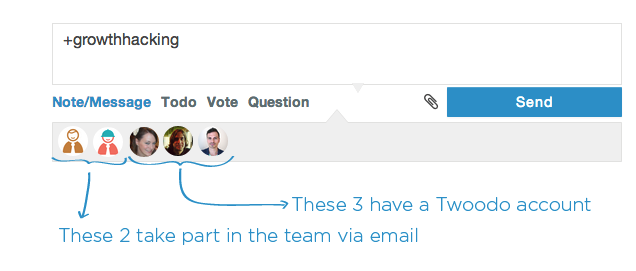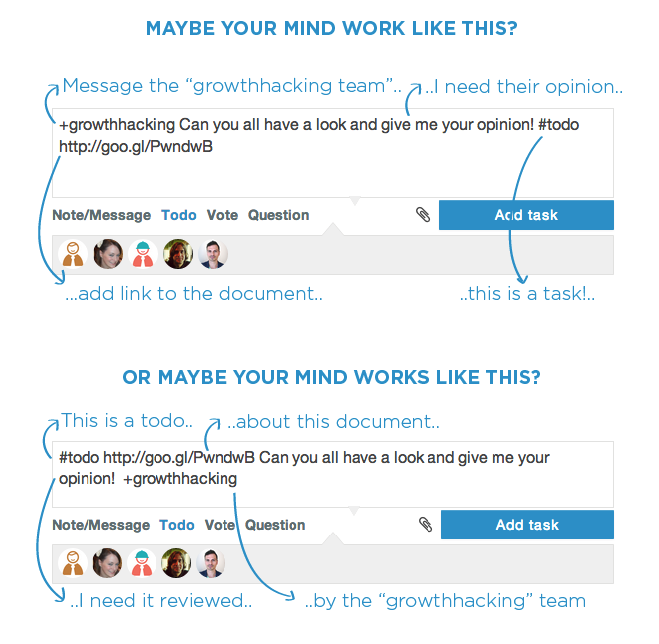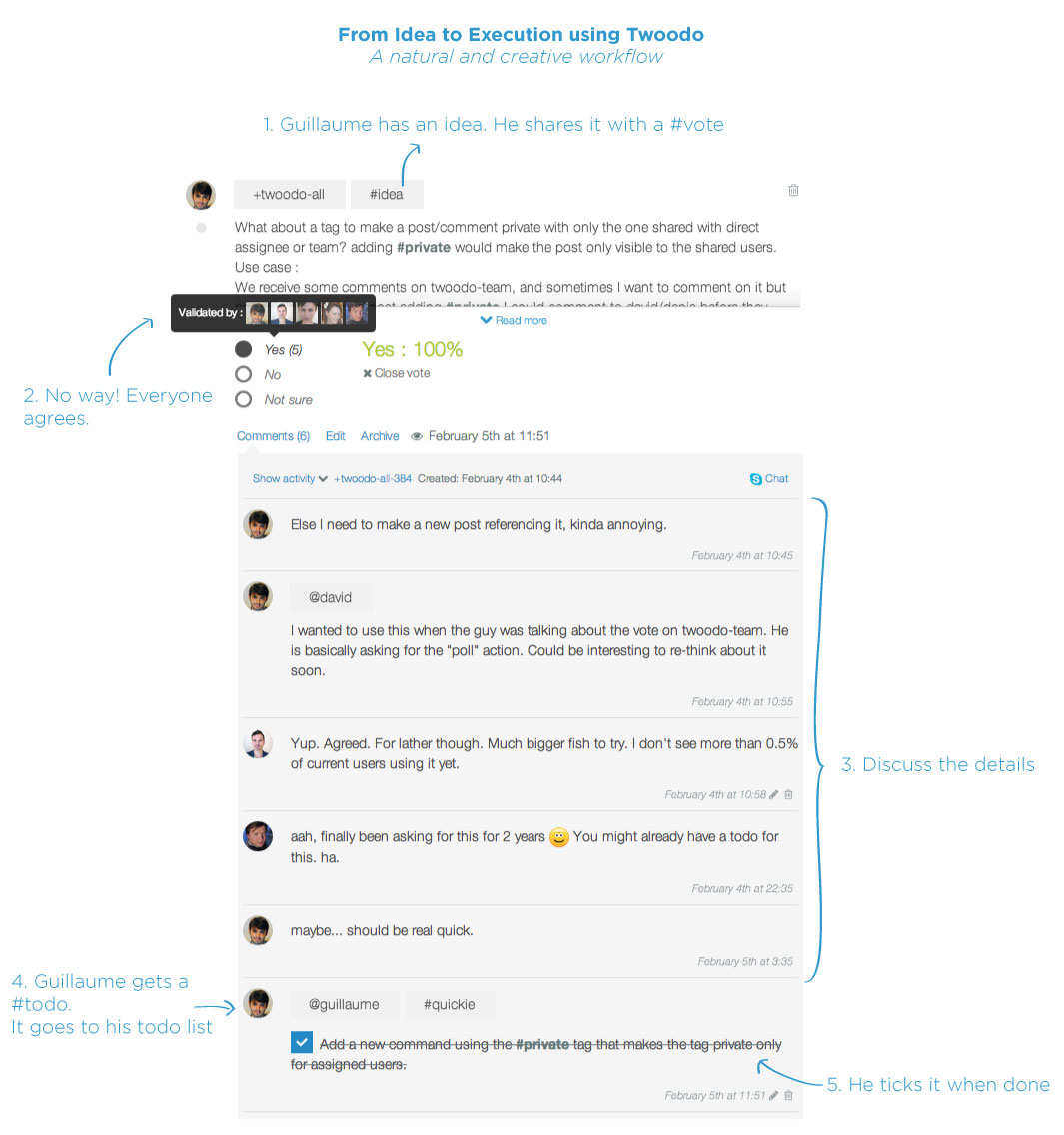More and more people are switching to virtual teams - I mean, why wouldn’t you? No more lost and exhausting commuting time, no more pointless sitting in traffic (ok ok you use that time to listen to ebooks on audible, but still!), no rushing to get out the door in the morning… Those one or two hours a day that you used to dread can now be put to good use. You can cook yourself a great lunch, go to the gym and have a shower or take that 15 power nap you keep reading about. Whatever pleases you!
In addition to that, with today’s technology, it’s not like you are completely disconnected. If you need to talk to someone, you use chat. Even in the office you tend to use IM instead of getting up and disturbing someone. It’s more respectful not to interrupt the other person while they are focusing.
If you have the courage, you might even take it a step further. Why not discover the world while working remotely? It is conceivable today to travel from NY to California to soak up some sunshine and nature for a week or two, and still achieve as much work if not more. Changing your habits can be great for your productivity. Do you really want to wait for your retirement to be too old to enjoy seeing the world and experiencing different cultures!?! OK, I might be taking it a bit far here, but I hope you can see my point.
So you decide to go for remote working. Your team is scattered across neighborhoods, cities, countries or even continents. You’re working in a virtual team. And it’s awesome. You’ve got the people, you’ve worked our the processes, now you need a way to clearly communicate and keep the feeling of being a tightly knitted team that gets things done. That’s where communication and collaboration tools come in. Here what I’ve learned from 5 years of working in a virtual teams and why we’ve built Twoodo the way we built it.
Chat
Chat is amazing. We revert to chat all the time, especially for video conferencing. We often use it when we share screens (by the way, you should check out zoom.us so much better than Skype for screenshares) to show something that we are working on or for quick answers to questions. But there are some difficulties when you are in a virtual team.
“Friendly” timezones
First and foremost, if you all happen to be in different timezones it might be complex to meet up in a chat system. Our team is spread over Hong Kong, Amsterdam, London, Paris and San Francisco, so we know the pain and the complexities of timezone differences. And even if your team is not so remote, it’s possible that you have clients, partners, consultants and freelancers in different timezones. The tool you opt for should be as timezone independent as possible. That means that no matter the difference, things will show up with the right time and date, like when setting up a meeting (for example). If I’m in California and I set up a meeting, there is no point in the rest of the team knowing what time the meeting is for me, they only care what time it will be for them, so when you set up a meeting in whatever tool you’re using that should all be done automatically. You should even be given a preview of what time it is going to be for the others to make sure they won’t be in a deep sleep.
Make each other accountable
You can assign all the tasks that you want in a chat, but you can be sure that most of them will disappear, or be forgotten, during the course of the conversation. This is even worse if you have a group chat - that thing you asked your colleague is going to be drowned out, forgotten and lost. You should only use chats for something that you really need now or just to chit-chat a little when you get lonely (wink).
So if you are going to assign tasks, ask questions or get people to vote on decisions, everyone should be held accountable. When you assign a task, you need to make sure it will not be lost. When you put up a vote as a validation for the next step, they can’t go back and say they didn’t voice themselves. Have you got an important question but don’t need an answer in a hurry? The tool you use should make it fast and easy to send, notify and track whether that question gets answered or not.
Have several conversations, at the same time or the right time
One of the biggest issues I see with chat is the impossibility of multi-threading a conversation. This is even more important when you consider the above-mentioned issue of timezones, and the fact that chat is so “immediate”. So, when you are talking to your team on chat, you have to pay attention that it might not be the right time for everyone.
Having a platform that allows you to have multiple conversations at the same time, or when the time is right for you, is super important. You’ll cover more ground with fewer messages and your messages with micro syntax are clearer, better organized and easier to follow. How often have you come back from a bathroom or coffee break to find 200 unread IM messages?! I just hate that!
I cannot argue with the power of email. You can literally talk to about four billion people around the world through email. Everyone has an email address. And because of that, unfortunately, you can’t just turn it off and ignore it. Because of that same fact, you need to find a tool that doesn’t force you, your team or your clients to turn away from it - but rather to embrace it. In our mind, the best tool that you can have is no tool at all, or as little as possible. The ideal tool should help you manage all that information smoothly in a unified and simple way.
Track the emails you send
I don’t know anybody that actually labels/tags the emails they send out, yet following up on people is super important. Instead we all merely adopt the “send and forget” syndrome based on the idea that if it’s important I’ll be reminded. That is a horrible non-productive habit, but yet I myself am guilty of it. Why do we do it? Because it’s a pain. When you send an email, you then need to go to the Sent box, find the email and then label it. Who wants to go through that? And then imagine the way the receiver organizes his emails – perhaps your task for him was not given the same importance as you would give it, and it doesn’t get done within a time that suits you! It’s out of control, and can drive anyone trying to get things done crazy.
What the ideal tool should offer is the possibility to seamlessly tag messages as you are sending them. Tag, store, track. You get to keep track and also be reminded of information you send out. You can avoid having to remind yourself to tag things. You get a clear list of all actionable items that you send out (even for yourself).
Collaborative emailing - stop double organizing
You know the feeling when you just finished something great and all of a sudden your computer crashes and you lose everything that you’ve done? That’s how I see email when we’re working in a team. I spend time and effort writing up something for a team, send it out, only to have them all process and interpret that information again. When you look at it from the team angle, it’s basically the same thing. I write something, organize it on my side, send it out, then the rest of the team have to organize it for themselves probably in a very similar way. For example a task will go from my mind, to a task list, to an email, they will read the email, interpret it and put it in their task list. Why??? It’s like constantly doing things twice or even three times! Why is it that email still can’t be truly collaborative? If I organize it for myself it should be organized for the other person as well so when he gets it, he just needs to have a quick read through it. You probably know how it is to come back from holidays and find 400 emails in your inbox that you have to process! Why can’t I trust the rest of my team to organize what they have sent me? If they make a mistake I can easily edit it but overall I would save myself hours of unnecessary extra toiling.
The perfect tool could be seen as a collaborative email system in some ways. I send out a message, tag with who it’s for, what it’s for, how urgent it is so that I can not only save & track it, but it’s also immediately organized for the receiver in their inbox.
Mark an end to ambiguity - Clear actionable messages
You know when you get those messages with the subject line: “Hey, how you doing?” followed by a big chunk of text and a task at the very end? It’s not very constructive for either of you. You don’t know the context, or what it’s for, until you open that email and read through it. As Paul Graham said: when I get an email I want to know if it’s something to read or something to do, if it’s something to do, I want to know how important it is or when is it due. I absolutely agree, but I would add one more to the list: what is the context of the message?
The ideal collaboration tools should do that for you. You want to say it’s something to do, add #todo. You want to say it’s something important, add #high. You want to know when it’s due, add /tomorrow. You want to add context, add something like #bug, #sales. And BAM, your message is clear right away, leaving no room for ambiguity.
Collaboration tools
There are a lot of websites and tools out there offering team collaboration tools or social collaboration solutions. But just knowing that shows us that something still isn’t quite right. No-one has truly cracked the nut yet. Many of these solutions are for tracking tasks (todo lists, shares task lists, task management apps), but that’s just adding another tool to your belt. Some are only for communicating (chat tools, messaging tools) – but that’s just adding another tool on top of your email. Some do both, but they forget that we are human beings that need to be wooed into doing something – you can’t separate communications from tasks. Let’s go over some of these.
I don’t want to change my habits
From the many customer interviews we’ve carried out with small and large companies alike, by far the biggest perceived pain of collaboration tools is that by their very existence, having to learn yet another “solution”. Developing new habits is a pain. If somehow you manage to convince yourself that the new tool you’ve found IS THE SOLUTION you’ve always been looking for, then unfortunately a second barrier kicks in. You need to change the habits of everyone on your team, get them to join you on this new application. When we launched the private beta version of Twoodo we saw waves of people to whom this was happening. We would get one person on the team to fall in love with the Twoodo system, two to follow him in adopting the tool but then all would fall apart when it came to convincing one or two other reticent colleagues. The general statistic we found tended to be the same throughout all teams, 75% were willing to adopt, the remaining unwilling 25% spoiled it for the rest of them. Management styles tend to be much more relaxed today. “If the team doesn’t adopt the tool, I’m not going to force them”.
The ideal tool is a place where you can collaborate with your team (or third parties) without forcing them or needing them to use it too! How beautiful is that? This can be achieved by integrating a tool they are currently using. 99% of the time that will be email. You can send and track all your messages, tasks, questions from the tool and be sure your recipients are receiving it.
With Email integration we’ve made it super simple to include people via their email into one of your work teams.

New tools are complicated to use
When you use most collaboration tools, our research shows that it takes an average of eight steps to enter a task for someone! EIGHT! So even after you’ve got your team using a new tool, it still takes longer than sending an email. No wonder people have a hard time adapting to “collaboration tools”.
- First you need to have the task at hand…
- then go to the right project/team that you want to communicate with…
- then you type your task…
- then you set an assignee with your mouse…
- then you set the date…
- then set the importance…
- and voila! Your task is in the system.
We have a strong belief that using a collaboration tool should feel natural, just like talking, and shouldn’t take eight steps.
Adding hashtags is super fast and you don’t need to be a power user, just a little web savvy. Most importantly it follows your train of thought – you don’t need to go to a special project/team page to write the message, you just write it and tag it, give it an action, assign it to someone, in whatever order your brain gives you the information in. Plain and simple.

I don’t want tasks and orders shouted at me
I know this might come as a shock, but I don’t see myself like a computer than can be programmed to execute actions. I need to be coaxed into doing something, and I think you are probably similar. A mistake that I think most collaboration tools do is separate the conversations, the chit-chat from the actions or to-dos. You end up finding yourself with a pile of tasks that you need to execute without feeling like you contributed. They might not even be clear tasks. So it’s back to your email to clarify it all. That just doesn’t feel right. These tools make you have your conversations on one side and your actions on another.
We don’t see it that way. It’s a bit like Confucius said: “Tell me, and I will forget. Show me and I may remember. Involve me, and I will understand.” We believe that great companies happen because of the team, because they all have a common objective, and that great things are achieved by working together.
The very core of teamwork is not actions, it’s collaboration with your team and the tool you use should empower you to have a conversation naturally, just like you would face to face. It should allow you to make that conversation evolve into action, not the other way around. With Twoodo we’re turning your conversations into actions.


